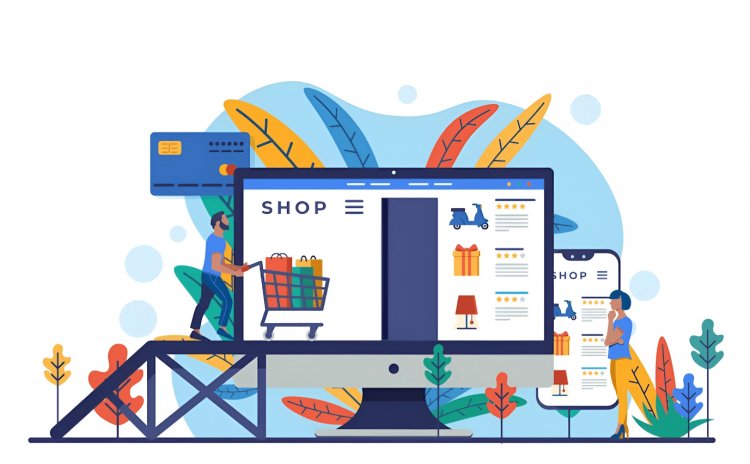E-Commerce in the Digital Age: How Technology is Revolutionizing Retail
E-commerce is revolutionizing retail with technology, offering benefits like convenience and efficiency, while also presenting challenges. This article examines how e-commerce is changing the way people shop in the digital age.

E-commerce has become an integral part of the retail industry, and technology has played a significant role in its growth. From personalized product recommendations to mobile shopping apps, technology has revolutionized the retail industry in several ways.
Convenience: The Power of E-commerce
One of the most significant ways technology has revolutionized retail is by making shopping more convenient. Convenience is a major factor in the success of e-commerce. Some of the key points to consider about convenience are:
-
24/7 availability:
Unlike brick-and-mortar stores that have set hours, e-commerce sites are available 24/7, allowing customers to shop whenever it's convenient for them. -
No geographic boundaries:
E-commerce allows customers to shop from anywhere, without the need to travel to a physical store. This is especially convenient for people who live in rural areas or who have limited mobility. -
Comparison shopping:
E-commerce makes it easy for customers to compare prices and products across multiple retailers, without the need to physically visit each store. -
Fast and easy checkout:
E-commerce checkout processes are often faster and easier than traditional checkout processes, allowing customers to complete their purchases quickly and easily. -
Home delivery:
With e-commerce, customers can have their purchases delivered directly to their door, eliminating the need to travel to a store and carry heavy or bulky items home. -
Auto-ship and subscription options:
Many e-commerce sites offer auto-ship and subscription options, allowing customers to receive regular deliveries of their favorite products without having to remember to reorder them.
Overall, the convenience offered by e-commerce is a major driver of its success. By providing customers with a fast, easy, and hassle-free shopping experience, e-commerce has become a preferred shopping method for many consumers. As e-commerce continues to evolve and improve, it is likely that it will become even more convenient and appealing to customers in the years to come.
The Rise of Personalization in E-Commerce
Another significant benefit of e-commerce is the ability to provide personalized shopping experiences. E-commerce retailers collect vast amounts of data on consumer preferences and behaviors and use this data to make tailored product recommendations. For instance, Amazon's "recommended for you" feature suggests products based on a user's past purchases and browsing history. Personalization can lead to higher customer satisfaction and increased sales as consumers are more likely to buy products that meet their interests and needs.
The Expansion of E-Commerce
The expansion of e-commerce has been a defining characteristic of the retail industry in the digital age. With the rise of the internet and the increasing use of mobile devices, consumers are now able to shop online from anywhere and at any time. As a result, e-commerce has grown at an unprecedented pace, and it is showing no signs of slowing down. Here are some of the key factors driving the expansion of e-commerce:
-
Increased access to technology:
The growing availability and affordability of technology, including smartphones, tablets, and computers, has made it easier for consumers to shop online. With the ability to shop from the comfort of their own homes, consumers are increasingly turning to e-commerce for their shopping needs. -
Convenience:
One of the biggest draws of e-commerce is its convenience. With the ability to shop online 24/7, consumers no longer have to worry about store hours or wait in long checkout lines. This has made e-commerce an attractive option for time-strapped consumers. -
Global reach:
E-commerce has the potential to reach customers around the world, providing retailers with a global market for their products. This has been particularly beneficial for smaller retailers, who may not have the resources to expand their brick-and-mortar presence to other countries. -
Innovations in technology:
E-commerce platforms are constantly innovating, introducing new features and technologies to improve the shopping experience for consumers. From mobile apps to virtual reality shopping experiences, these innovations have helped to drive the growth of e-commerce and keep it at the forefront of the retail industry. -
Increasing Popularity of Social Media:
Social media platforms, such as Facebook, Instagram, and Pinterest, have become important channels for e-commerce retailers to reach and engage with consumers. Retailers can use social media to promote their products, build brand awareness, and drive traffic to their e-commerce platforms. Social media also provides a way for consumers to discover and share products with their friends and followers, helping to drive sales and increase brand awareness. As social media continues to grow in popularity, it is likely that it will become an increasingly important channel for e-commerce retailers.
Overall, the expansion of e-commerce has been driven by a range of factors, including increased access to technology, convenience, personalization, global reach, and innovations in technology. As the e-commerce industry continues to evolve, it is likely that we will see even more growth and innovation, as retailers seek to meet the evolving needs and expectations of today's consumers.
Automation and Efficiency
Advancements in technology have made it easier for retailers to manage their inventory and fulfill orders. Some of the areas of automation and efficiency in e-commerce are:
-
Streamlined operations:
E-commerce platforms use automation to streamline a range of operations, including inventory management, order processing, and shipping. This helps retailers to reduce costs, improve efficiency, and increase their overall profitability. -
Faster order processing:
With e-commerce, orders can be processed and fulfilled more quickly than with traditional retail. This is because e-commerce platforms can automate the order processing and fulfillment process, reducing the time it takes to process orders and get them shipped out to customers. -
Real-time inventory management:
E-commerce platforms use automation to track inventory in real-time, allowing retailers to more accurately manage their stock levels and avoid stockouts. -
Predictive analytics:
AI-powered predictive analytics can help retailers to better understand their customers and anticipate their needs. By analyzing data on customer behavior and purchasing patterns, retailers can make better decisions about product development, pricing, and marketing. -
Product recommendations:
E-commerce platforms can use AI algorithms to analyze customer data and make personalized product recommendations. By recommending products that customers are more likely to be interested in, retailers can increase sales and improve customer satisfaction. -
Customer service:
E-commerce platforms can use chatbots and other automated tools to provide customer service, reducing the need for human customer service agents and improving response times.
Challenges of E-Commerce
The rise of e-commerce has undoubtedly transformed the retail industry, bringing about a host of benefits for consumers and retailers alike. However, along with its many advantages, e-commerce also presents its own set of challenges. Here are some of the key challenges of e-commerce:
-
Cybersecurity risks:
One of the biggest challenges that e-commerce retailers face is the threat of cyber attacks and data breaches. With the increasing amount of sensitive customer data being collected and stored online, e-commerce platforms are an attractive target for cybercriminals. Retailers must invest heavily in cybersecurity measures to protect their customers' data and maintain their reputation. -
Fulfillment and logistics:
Another challenge that e-commerce retailers face is the complexity of order fulfillment and logistics. Online retailers must ensure that they have an efficient system in place to handle and deliver orders to customers in a timely and cost-effective manner. This can be a daunting task, especially for smaller retailers who may not have the resources or expertise to manage their own logistics. -
Customer trust and satisfaction:
Trust is essential for any successful e-commerce business. Retailers must maintain high levels of customer satisfaction to build and maintain trust in their brand. However, this can be challenging, as online shoppers have high expectations when it comes to product quality, shipping times, and customer service. Retailers must work hard to ensure that they are providing a positive and seamless shopping experience for their customers. -
Competition:
As the e-commerce industry continues to grow, the competition between retailers has become increasingly intense. To remain competitive, e-commerce businesses must continually innovate and find ways to stand out from the crowd. This can be challenging for smaller retailers, who may not have the resources to invest in the latest technology or marketing strategies. -
Impact on traditional retailers:
The growth of e-commerce has also had a significant impact on traditional brick-and-mortar retailers. As more consumers turn to online shopping, traditional retailers are finding it increasingly difficult to compete. This has led to store closures and job losses, and many retailers are struggling to adapt to the changing retail landscape.
Overall, e-commerce has brought many benefits for retailers and consumers alike, but it is not without its challenges. Retailers must work hard to maintain high levels of customer satisfaction, invest in cybersecurity measures, and find ways to stand out in an increasingly crowded market. As the e-commerce industry continues to evolve, retailers will need to be agile and adaptable to stay ahead of the curve.
In conclusion, technology has had a significant impact on the retail industry, revolutionizing the way consumers shop and transforming the way retailers do business. E-commerce has made shopping more convenient and personalized while also opening up new opportunities for retailers to reach a global audience. However, with these benefits come challenges, such as the threat of cyberattacks and the need to adapt to the changing retail landscape. As technology continues to evolve, the retail industry will need to stay ahead of the curve to remain competitive and provide the best possible shopping experience for consumers.
What's Your Reaction?








































































































